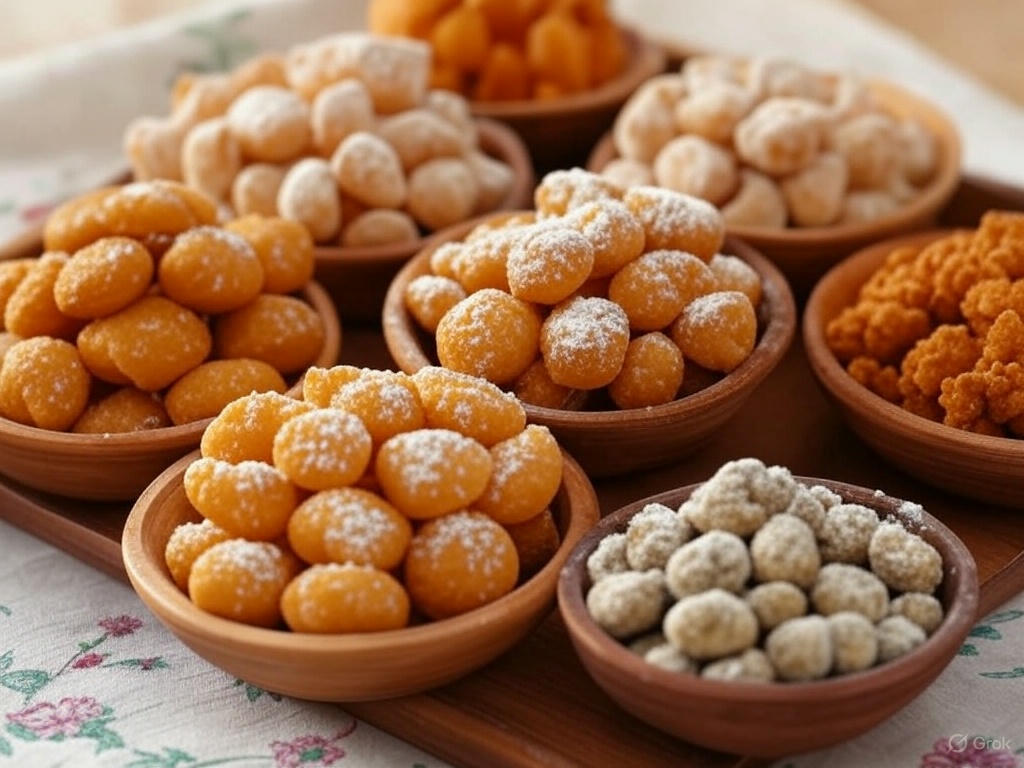Unhealthy Persian Snacks: Tasty but Tricky
Persian sweets, rich in sugar and fat, hold a special place in Iranian culture. From pastries like baghlava to fried dough like bamieh, these treats tempt taste buds. For example, they’re made with ghee or syrup in Iran’s kitchens. This article explores why these goodies are loved, how they’re prepared, and their health downsides. Plus, we’ll look at their cultural role, ingredients, and why they’re still popular. As exporters of saffron, nuts, and more, we focus on healthier options, but these indulgences tell a story too. So, learn why unhealthy Persian snacks are a tricky delight, how they fit into Persian life, and what makes them hard to resist. Join us to uncover these rich bites and their place in Iran!
Introduction
Persian treats tempt Iranians with bold flavors. These rich goodies, like sugary baghlava or oily bamieh, pop up at celebrations and tea times. They’re made in Iran’s homes and bakeries, often with lots of sugar or fat. We export saffron, nuts, and dates—healthier stuff—but unhealthy Persian snacks are part of the food scene too. This article isn’t about exports—it’s about why these sweets matter in Iran. It covers their taste, risks, and traditions. Let’s dig into this tricky tale!
The Roots of Unhealthy Snacks in Iran
These indulgences have old roots in Iran. They come from cities like Yazd for sweets or Tehran for fried bites. Long ago, people made them for feasts or guests. Today, they’re still baked or fried in big batches. Most are enjoyed at home, but some sell on streets. For example, cooks drown them in syrup or ghee for flavor. So, unhealthy Persian snacks are tied to Iran’s past.
Why These Snacks Are Loved
These treats win hearts for simple reasons. First, they taste sweet or savory in a big way. Next, goodies like shirini nokhodchi or zulbia melt in your mouth. Also, they’re tied to happy times like holidays. Compared to plain nuts, these sweets feel like a party. As a result, they’re hard to skip in Iran.
How These Snacks Are Made
Making these goodies takes skill and rich stuff. Here’s how it works:
- Mixing: Flour, sugar, or chickpeas get blended with ghee or oil.
- Shaping: Dough is rolled into stars, balls, or strips.
- Cooking: They’re fried in oil or baked till golden.
- Soaking: After, they soak in syrup or honey.
- Cooling: Finally, they’re ready to eat or share.
So, this rich process makes these treats a heavy delight.
Unhealthy Snacks in Persian Life
These sweets pop up everywhere in Iran. For example, baghlava layers nuts with syrup for Nowruz. Bamieh and zulbia drip with sweetness at Ramadan iftars. Also, people grab shirini tar at tea shops for a quick bite. Another way? Serve koloocheh at weddings for cheer. Because of this, unhealthy Persian snacks are a daily temptation.
Health Downsides of Persian Snacks
These goodies can hit your health hard. For example, too much sugar in bamieh spikes blood sugar. Fried zulbia packs oil that’s tough on your heart. Plus, ghee in shirini adds extra fat. Another issue? Eating lots can pile on weight fast. So, these treats need a careful balance.
Snacks in Persian Culture
These indulgences aren’t just food—they’re tradition. For instance, baghlava marks sweet moments like births. Families fry bamieh together for Ramadan bonding. Also, old habits say sweets bring joy. Another custom? Sharing shirini with neighbors for luck. Because of this, unhealthy Persian snacks hold a deep spot in Iran’s culture.
Persian Snacks and Local Life
These sweets shape Iran’s daily buzz too. They fill bazaars and shops with tempting smells. Places like Isfahan and Qom are famous for them. Since healthy stuff like nuts can’t always compete, these treats stay strong. They also keep small bakers busy. We export saffron and nuts, but these goodies tell a local tale.
Global Reach of Persian Snacks
Some folks outside Iran try these sweets too. Why? First, they’re a fun twist on desserts. Next, Persian shops abroad sell baghlava or koloocheh. Also, travelers grab them as souvenirs. For instance, expats bake shirini nokhodchi for nostalgia. Iran shares these rich bites globally. So, they spread a little.
Challenges with These Snacks
Making these treats can be messy. For example, frying bamieh needs hot oil and care. Then, syrup for zulbia can sticky up kitchens. Plus, keeping them fresh is hard without fridges. However, Iran keeps churning them out to satisfy cravings for these goodies.
Opportunities to Balance Snacks
There’s room to tweak these sweets. For instance, less sugar could lighten baghlava. Also, baking instead of frying zulbia cuts oil. Another idea? Mix in nuts for a healthier twist. We focus on healthy exports, but these tweaks could shift unhealthy Persian snacks a bit.
How to Spot These Persian Snacks
Want to try these goodies? Here’s what to look for:
- Feel: Sticky or oily means they’re rich.
- Look: Golden brown or shiny is a clue.
- Taste: Super sweet or savory stands out.
- Source: Bakeries or bazaars have the real deal!
This way, you spot these treats easily.
Persian Snacks Around the World
These indulgences flavor life beyond Iran. In Iran, they’re at every fest. In Europe, Persian cafes serve baghlava with tea. And Asia, folks try zulbia as a rare bite. For example, you can pair shirini with coffee too. Because of this, unhealthy Persian snacks sprinkle taste globally.
The Future of Persian Snacks
The future mixes old love with new thoughts for these sweets. Health trends might trim their sugar or fat. Also, people still crave their comfort. We export healthier saffron and nuts, but these bites will linger. So, these treats will stick around in Iran.
Conclusion
Unhealthy Persian snacks blend tradition with temptation. People in Iran and beyond enjoy their taste, stories, and risks. If you’re curious or a sweet tooth, these goodies call out. We send healthier options with care, but these tell a tale too. Want a taste? Visit a bazaar to try these indulgent bites. Let’s savor this tricky delight together!


